Amazing Artisan Bread for 40 Cents a Loaf - No Kneading, No Fussing, No Kidding
 February 26, 2010
February 26, 2010 Update: If you're interested, I've written an update on this technique here.
What if I told you that instead of buying bakery bread for four or five dollars a loaf, you could make delicious handmade bread whenever you wanted, at a fraction of the cost and it is so easy a kid could do it? Well, read on because this method of making artisan bread at home will change your life.
You can make incredible bread without having to do all the usual time consuming tasks of breadmaking :
- no need to make a new batch of dough every time you want bread
- no need to proof yeast
- no need to make starters or prefermented dough
- no kneading!
In the last few years, several methods for making easy no-knead bread doughs have crept up on the internet and gained popularity. Among the most popular have been Jim Leahy's No-Knead Bread and Jeff Hertzberg and Zoe Francois' Artisan Bread in Five Minutes a Day. These breads drastically cut down the amount of time and work that it was always assumed had to go into artisan bread making. Even the Zen Master of bread making, Peter Reinhart, has jumped onto the bandwagon, admitting that these no knead methods have made him rethink everything he knew about breadmaking:
"The results have forced me to reconsider all of the premises I once held sacrosanct".
So what is going on here?
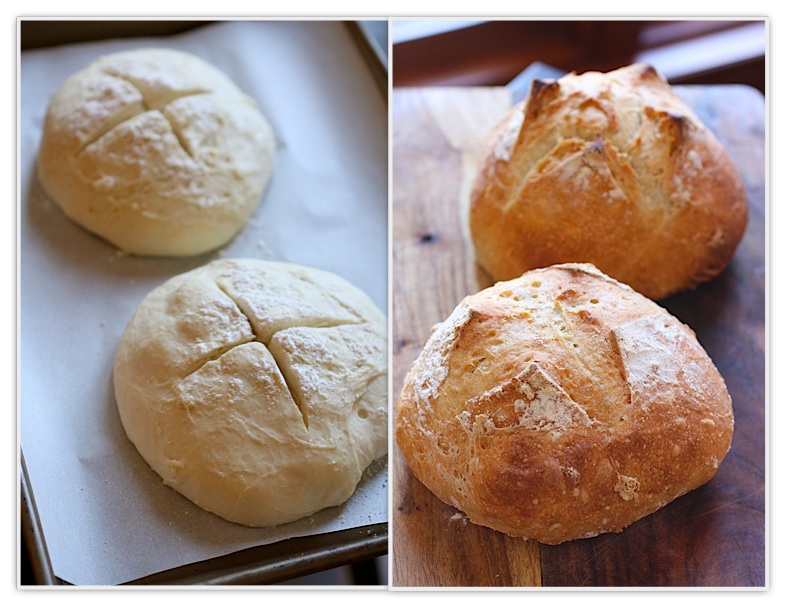
Boules Rising and Boules after Baking
The key is mixing up a high moisture, or "slack" dough, and letting it do a long fermentation in the refrigerator. It's long been known that a long fermentation contributes flavor to dough but it seems it also develops gluten and eliminates the step of kneading. The advantage in using refrigeration is that you can control the fermentation and you can make up a large batch of dough, enough for four loaves, and keep it in the fridge. If you make a very wet dough, it will be able to last in the refrigerator a long time, gaining flavor as it ferments and allowing you to make bread whenever you decide. This is not to say there is not a place for multi-stage, time-consuming bread making techniques which require 15 minutes of kneading - I love making my homemade focaccia, which takes three rises every time I make a batch. But this bread is absolutely a no-brainer. You mix up a big batch of dough in one container, a process which takes only a couple of minutes (remember, there is no proofing of yeast or starters to make). When you want bread, you cut off a hunk of dough and shape it. You can make various sizes and shapes: boules, batards, rolls or baguettes. It's just so convenient and makes such a beautiful bread with a crackly crust, you won't believe it. I've even shaped the dough into rolls. Peter Reinhart points out that the home baker has an advantage over the commercial baker with this technique - the commercial bakery does not have the refrigeration space to use a method like this. As a home baker, we can make up small batches of dough, refrigerate it and enjoy fresh bread whenever we want it. If you are buying fresh bread three times a week at $4.00 per loaf, you are spending about $50 a month on bread! This bread is only about 40 cents a loaf to make. And, since bread is best the day it is made, you don't have to drive to the grocery/bakery to get it every time you want a loaf.
To see how easy it is to get a loaf ready, you can watch me form a loaf in about 30 seconds:
This bread is very versatile, also. In both Peter Reinhart's book and Jeff Hertzberg and Zoe Francois' book, they give you many variations of breads made with the master bread recipe in each book. You can make whole wheat breads, cheese breads, herb breads, breads stuffed with sun dried tomatoes, Challah, Semolina Bread and on and on. Jeff Hertzberg and Zoe Francois have come out with another book, "Healthy Breads in Five Minutes a Day", for people who would like more whole grain recipes and gluten free breads. This is a great book, too, and has lots of wonderful ideas in it. I have all three books and strongly recommend them if you want to try easy bread making. It's nice to be able to make bread whenever the whim hits you - I have several types of doughs in my refrigerator, happily fermenting away.
In these recipes, instant yeast is used, which eliminates the need for "proofing" the yeast. Everything is simply mixed together. If you are interested in learning more about yeast, my recent "Yeast Explained" post may be of interest to you. Instant yeast is sometimes labeled "fast acting yeast" and is sold under the names of "Rapid Rise" and "Quick Rise" yeast. Also, Bread Machine yeast is simply instant yeast. I like to buy my yeast in the little jars instead of the packets because I can use only as much as I need out of the jar and it tends to be cheaper.

One way of letting the dough rest and rise is to place it on a pizza peel, dusted with some cornmeal. This works well when we make pizzas and pop them right into the oven. However, for this the bread seems to stick because you have to let it sit so long on the pizza peel and rest. So I place a small square of parchment paper on the pizza peel and put the dough right on that. When I slide it into the oven, it goes in along with the parchment paper and bakes up beautifully. If you want an extra crispy crust, just remove the parchment paper halfway through the baking time and return the bread to the pizza stone - this is what I do.
The dough can be stored in any plastic container with a lid or a bowl with plastic wrap placed over it. You want the gases to be able to escape as the dough rises, though - so wrap the plastic wrap over the bowl tightly and then puncture a little hole in the top. It is nice to have a dedicated plastic container, though, in the fridge for your dough, because you are going to just keep it in there all the time. Although these containers are recommended by the authors and the King Arthur Flour website has these nice dough rising buckets, I bought a square plastic-lidded container at my local grocery store because I thought it fit in my fridge better. You can see it in the photos below. I place the lid on tightly, but I punched a small hole in the top. This is important to do.
So get out a bowl if you don't have a plastic container, mix up a batch of dough and have your first loaf tomorrow. You won't believe it.
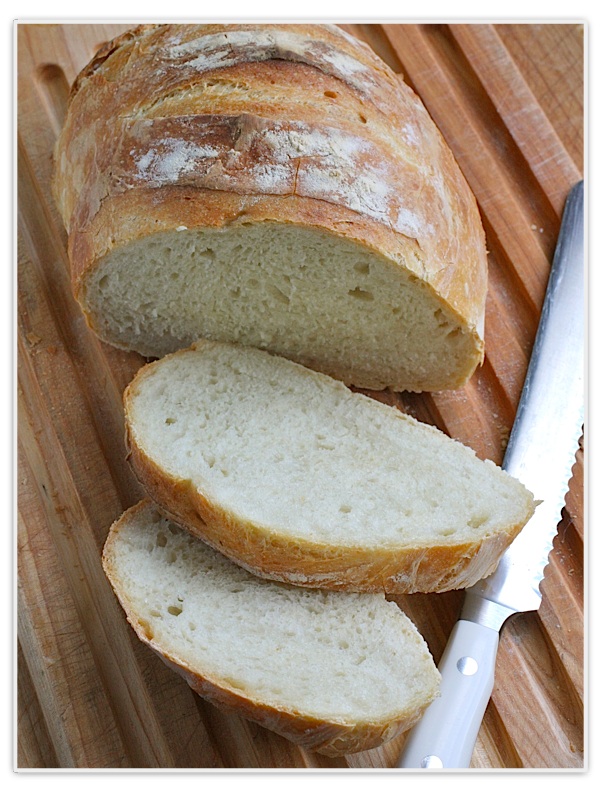
No Knead Artisan Bread
adapted from Artisan Bread in Five Minutes a Day
for a printable recipe, click here
makes four 1 pound loaves.
Ingredients:
- 3 cups lukewarm water
- 1½ tablespoons granulated fast acting (instant) yeast (2 packets)
- 1½ tablespoons kosher or other coarse salt
- 6½ cups unsifted, unbleached all purpose white flour*
(My favorite way to make this bread now is to use half bread flour, half all-purpose flour and throw in ½ cup wheat bran into the dough.)
*After baking, if your bread is gummy on the inside, try either increasing the amount of flour by ½ cup and/or increasing the baking time by 10 minutes.
Instructions:
Mixing and Storing the Dough
1. Warm the water slightly. It should feel just a little warmer than body temperature, about 100 degrees F. Warm water will rise the dough to the right point for storage in about 2 hours.
2. Add yeast and salt to the water in a 5 quart bowl or a plastic container with a lid.
3. Mix in the flour - kneading is unnecessary. (Note: I dump all this in my KitchenAid mixer, let it mix it for just about 10 seconds and then put it in the plastic container. I just find it easier to let the mixer do this part). Add all of the flour at once, measuring the flour by scooping it and leveling it off with a knife. Mix with a wooden spoon - do not knead. You're finished when everything is uniformly moist, without dry patches. This step is done in a matter of minutes. The dough should be wet and loose.
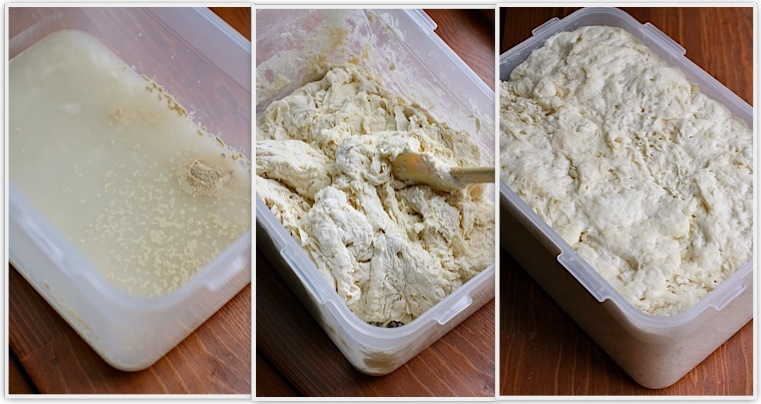
4. Allow to rise. Cover with a lid (not airtight). Lidded plastic buckets designed for dough storage can be purchased many places. (I used a plastic square food storage container I got at my local grocery store. I now use a Rubbermaid 21-cup Dry Food Container. I punched a hole in the top). You want the gases to be able to escape a little. Allow the mixture to rise at room temperature until it begins to collapse (or at least flattens on top), about two hours. Longer rising times will not hurt your dough. You can use a portion of the dough any time after this period. Fully refrigerated wet dough is less sticky and is easier to work with than dough at room temperature. So, the first time you try this method, it's best to refrigerate the dough overnight (or at least 3 hours) before shaping a loaf.
Baking
5. Shape your loaf. Place a piece of baking parchment paper on a pizza peel (don't have a pizza peel - use an unrimmed baking sheet or turn a rimmed baking sheet upside down). Sprinkle the surface of your dough in the container with flour. Pull up and cut off about a 1-pound piece of dough (about the size of a grapefruit), using scissors or a serrated knife. Gently stretch the surface of the dough around to the bottom on all four sides, rotating the ball as you go. Dust your hands with flour if you need to. This is just to prevent sticking - you don't want to incorporate the flour into the dough. The top of the dough should be smooth - the object here is to create a "gluten cloak" or "surface tension". It doesn't matter what the bottom looks like, but you need to have a smooth, tight top. This whole step should take about 30 seconds! Place the dough onto your parchment paper.

6. Let the loaf rise for about 30 - 40 minutes (it does not need to be covered). If it doesn't look like it has risen much, don't worry - it will in the oven. This is called "oven spring".
7. Preheat a baking stone on the middle rack in the oven for at least 20 minutes at 450 degrees F. Place an empty rimmed metal baking pan or broiler pan on a rack below the baking stone. This pan is for holding water for steam in the baking step. (If you don't have a baking stone, you can use a baking sheet, but you will not get the crisp crust on the bottom. You will still have a great loaf of bread. Baking stones are cheap and easy to find - Target carries them - and are a must for making pizzas, so go out and get one as soon as you can.)

8. Dust the loaf with a little flour and slash the top with a knife. This slashing is necessary to release some of the trapped gas, which can deform your bread. It also makes the top of your bread look pretty - you can slash the bread in a tic tac toe pattern, a cross, or just parallel slashes. You need a very sharp knife or a razor blade - you don't want the blade to drag across the dough and pull it. As the bread bakes, this area opens and is known as "the bloom". Remember to score the loaves right before baking.
9. Bake. Set a cup of water next to your oven.* Slide the bread (including the parchment paper) right onto the hot baking stone. Quickly pour the water right into the pan underneath the baking stone and close the oven door. This creates the necessary steam to make a nice crisp crust on the bread. Bake at 450 F for about 30 - 35 minutes, depending on the size of your loaf. Make sure the crust is a deep golden brown. When you remove the loaf from the oven, you will hear it crackle for a while. In baking terms, this is called "sing" and it is exactly what you want.
* update: I have recently begun skipping this step with the water. I believe it caused my oven window to eventually crack and I have found that my bread is still great even without the water. If you want an extra crispy crust, though, it is worth doing once in a while
10. Cool. Allow the bread to cool for the best flavor and texture. It's tempting to eat it when it's warm, and that's fine, but the texture is better after the bread has cooled.
11. Store the remaining dough in the refrigerator in your lidded (with a hole punched in the top) container and use for up to 14 days. Every day your bread will improve in flavor. Cut off and shape more loaves as you need them. When your dough is gone, don't clean the container. Go ahead and mix another batch - the remaining bits of dough will contribute flavor to the next batch, much like a sourdough starter does!
Bread is best eaten the day it is baked. Leftover baked bread is best stored at room temperature, unwrapped. Simply place the cut side of the bread on plate or counter. If your bread is gummy on the inside, try either increasing the amount of flour by 1/4 cup and/or increasing the baking time by 5-10 minutes.
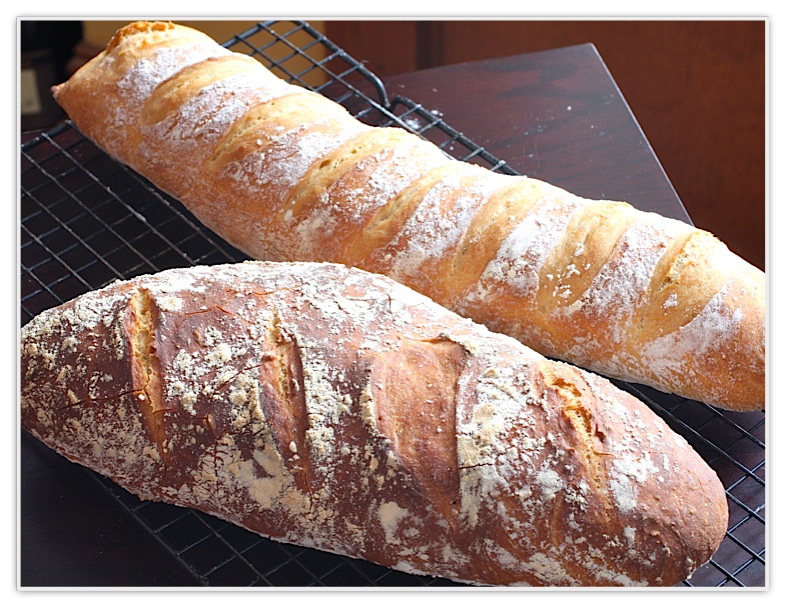
Check out the Artisan Bread in Five Minutes a Day website - Jeff and Zoe have great tips and recipes over there.

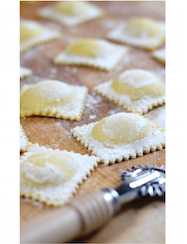
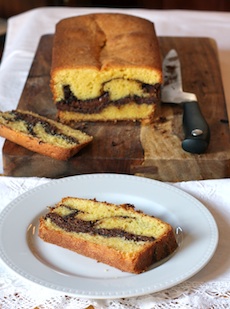
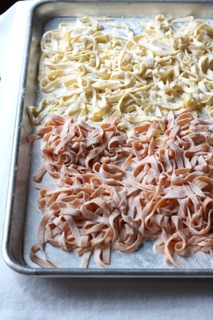
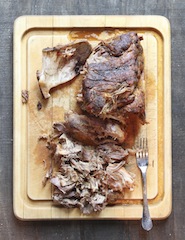
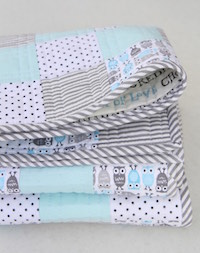
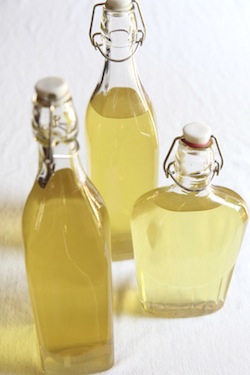
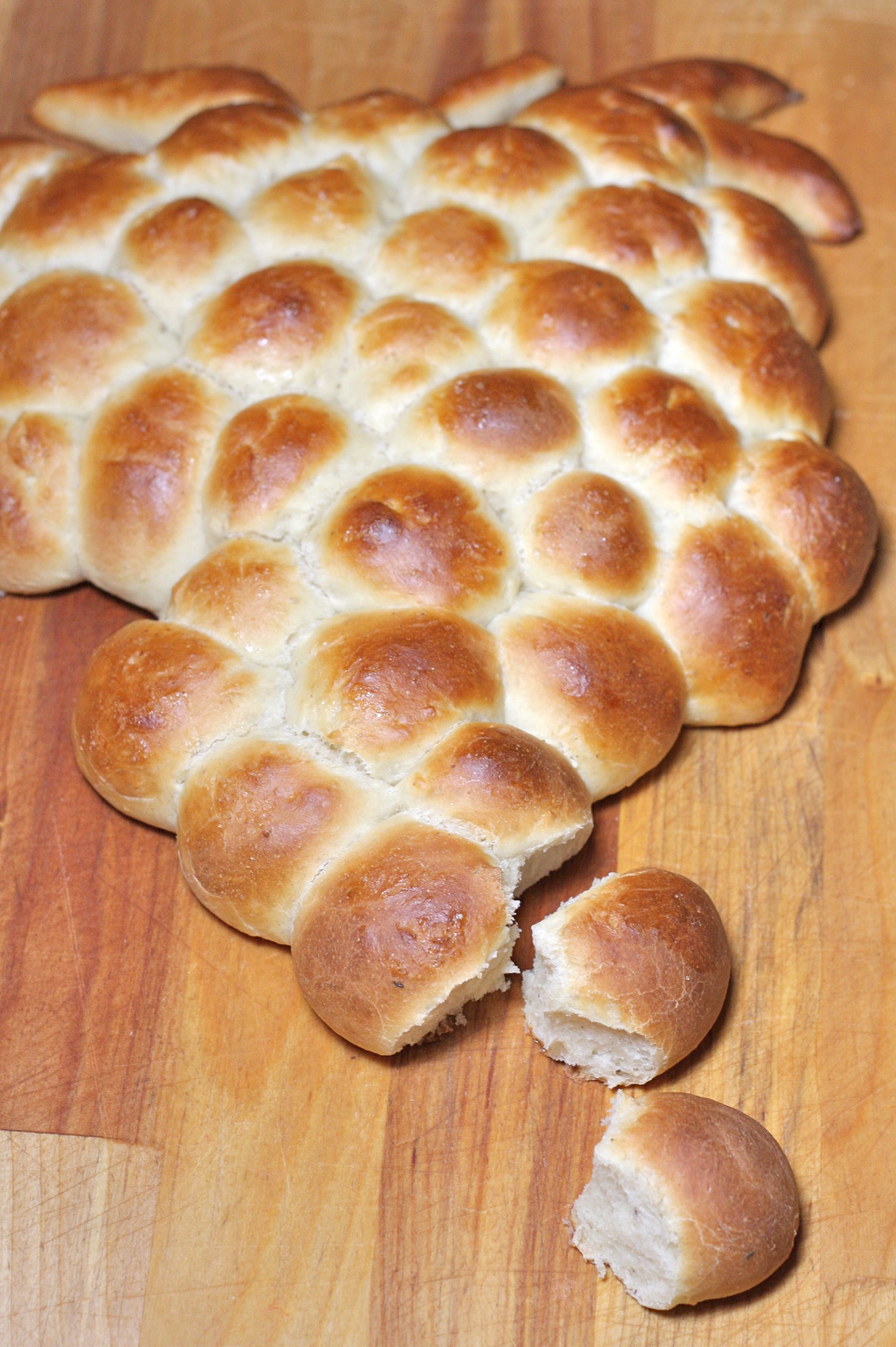

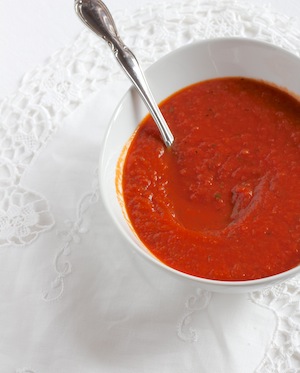
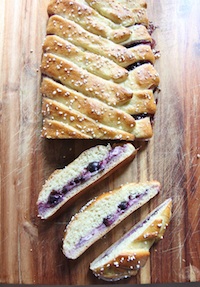

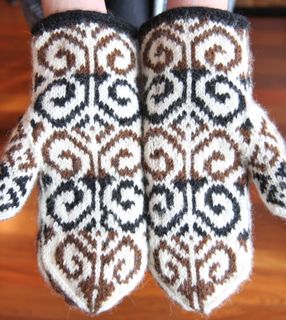






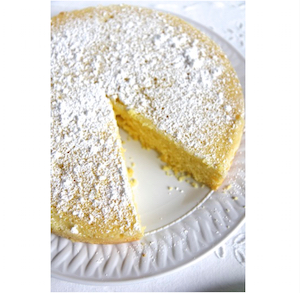
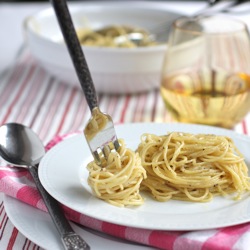


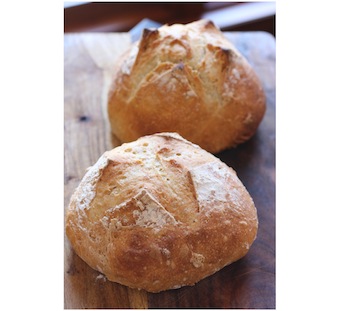


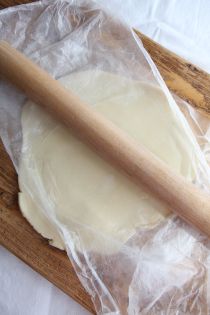

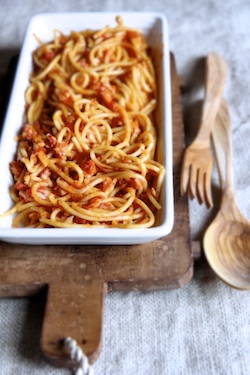
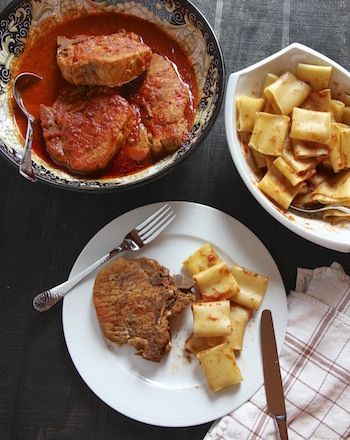









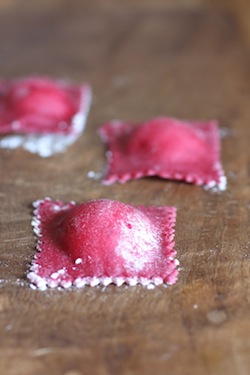

Reader Comments (468)
Another great recipe!
With this one, I use a nice whole grain flour and it is wonderful! It sure saves money compared to buying it from the bakery and it tastes even better! There's nothing better than the aroma of making your own bread!
Thanks!
Hi Eliane!
Just wanted to post a follow up and say thank you for the advice! You are right, the dough was huge by morning! :) But we baked it this weekend and it tasted just as wonderful as always! Got my Mom addicted to making this bread now too! :)
Thank you again so much for your help and for your wonderful blog!!
This bread really is wonderful! It's so very easy to make, no fuss at all. And tastes great! Thanks for the recipe.
I have made the bread several times and love the texture and flavor (having cut way back on the salt because it was too salty for our taste and reading here that it wouldn't affect the recipe, so thanks for that info). My problem is the recipe says it will make four one-pound loaves and I never get anywhere near that. Each is three-quarters of a pound or even less. I use King Arthur organic flour, reduce the amount of water by one-quarter cup per the instructions. The loaves look and taste lovely, but they are really small. Suggestions? Thanks!
From The Italian Dish:
Beverly: I took note of your comment the next time I made a batch and I actually weighed it to see how many pounds it was. It was just a shade under four pounds, so I think I am getting close to a pound for each loaf of bread. I don't know why you are getting a lot less. This dough is so flexible, though - just make up a batch and a half each time and you can make larger loaves.
Thank you Elaine. Another friend had the same experience I have had, so I guess we will either increase the recipe or maybe make just three loaves, which I hope will work with the baking time. Could climate have an effect? We are in South Florida.
i had my grandma come help me make this the first time and she was sooo skeptical! she kept saying "are you sure you don't have to knead it?" then when it was all done and we ate our first slice she was so impressed and replied "i cant believe i've been doing it the hard way all these years!" She left with this link. ;)
thanks so much, im in love with this recipe (so is my husband, ha)...in fact im making some now!
Your blog was sent to me by a friend and it is great. I have been making the artisan bread using this method for about 4 months. We really like it but have one problem. The dough is sooo wet and very hard to make it as pretty as yours. It still tastes good just doesn't look as good. We follow the recipe exactly. At least, we think we are doing it right. Any ideas?
Do you know if this would work just as well if you used a whole grain flour?
I like rough bread with nice big bubbles or spaces in it like a typical ciabatta. What needs to be done to get that openness in the loaf. Does it maybe have to be a sourdough?
I "stumbled upon" this entry and am seriously intrigued. I've recently started using The Six O'Clock Scramble in order to make cooking for my family of 5 a less daunting proposition. This fits RIGHT in with my resolution to use whole, healthy foods on my table. I posted it on my Facebook page and it has been shared by a few of my friends. Maybe we'll have a bread bake-off! I've never made bread in my life (except for the 6 months I had a breadmaker before I gave the darned thing away).... but I'm going shopping for flour and yeast today so I can have some of this on the table by tomorrow!
THANKS!
From The Italian Dish:
Joanne: The dough indeed is very wet and it takes some practice to get a feel for how to shape the loaves. I have found that if I wet my hands just a little, the dough does not stick too badly. You must make that "gluten cloak" that I talk about in the video - stretching the dough from the top to the bottom, to create a smooth surface on top and tension. Keep trying!
Bluepenguin: Jeff and Zoe have actually come out with a follow up book called "Healthy Breads in 5 Minutes a Day". They have lots of whole grain recipes using this method. I posted a link to their web site at the bottom of this post. I have made this bread with whole wheat flour. I have also used half whole wheat and half white flour. I have also used "white" whole wheat flour. If you use all whole wheat flour, add about 1/4 cup of "vital wheat gluten" to your dough so that it will rise better. Also, a little sugar or honey helps - the whole wheat flour will not be as sweet as the white flour. Check out Jeff and Zoe's site for more on whole wheat baking.
Renee: I'm so glad you are going to bake bread! You won't believe how easy it is. I always have a batch on dough in my fridge now. (Sometimes a couple of different kinds). My college age son is baking this bread now all the time in the house he lives in with a bunch of guys. It's a hit!
This bread was simply amazing! This is maybe the 3rd time in my life making bread from scratch like this...it's usually just too much work but this was *SO* easy! I whipped up the dough last night in about 5 minutes & then made my 1st loaf this morning. My whole family was fighting over it - it was so good...perfect crust & chewiness w/ the holes I just love. Exactly like good restaurant bread! I just formed my 2nd loaf right now...took me all of 20 seconds. it's resting & then I'll pop it in the oven & It's done in 1/2hr....how can you beat that??
Thank you for this recipe & whoever sent me the link to this blog ( I can't remember who it was anymore!)
OMG, BREAD! NO WAY!
I hope you don't mind a couple of questions... I've made 3 batches of this since I first posted. My family is in LOVE with this bread. Tonight I made a loaf that I folded in some chopped roasted garlic in. It is Fab-u-lous!
My dough is WAY less stiff than yours looks in the pictures. When I let it "rise" for 40 minutes before putting it in the oven, I have a hard time keeping it from basically melting into a flat pile. I'm following the recipe EXACTLY and making sure to create the "tension" that you talk about. But it doesn't seem to help. What could be happening?
From The Italian Dish:
Renee: I'm so glad you are enjoying the bread. Next time you make a batch, use 1/4 cup more flour and then, when you are letting your loaf rise, only let it rise for 30 minutes. Try that and see if it solves your problem. If not, let me know! Good luck.
Awesome! Thanks SO much for the response! I have 2 loaves left to make from this batch and then I'll give that a try. It's pretty much flattened out in the first 10 minutes of the "rise" time. Hopefully the additional flour will put a stop to that!
i tried this last night and so excited to make up my first loaf today as soon as i get home.
one question though - the dough seems to have risen quite a bit (nearly outgrowing the 5 quart container). i punched it down before popping it into the refrigerator, but an hour or two later i noticed it was still rising! is this normal? should i punch it down a second time?
this one will be an experiment for me (i'm not much of a baker) but i'm keeping my fingers crossed. thanks!
From The Italian Dish:
Jared: You do not need to punch the dough down, ever. This is not like a regular dough that you punch down. Since it's such a wet dough, you just let it rise and then stick it in the fridge. It will continue to rise in the fridge, but should not go beyond the top of the container, since it will be cold. If it's rising beyond the container on the counter, your kitchen may just be too warm. If that's the case, just let it rise until it reaches almost the top of the container and then stick it in the fridge, even if it's not exactly two hours. The beauty of this recipe is that it is so flexible.
Good luck!
thanks elaine! that will certainly help for next time. but ... what if i already punched it down last night before i put it into the refrigerator? it's risen again to the top since then so hopefully it will still work out. if not i can try again. what do you think?
From The Italian Dish:
Jared: No problem if you punched it down. It should rise to the top of the container again. That's good. Like I said, this dough is really flexible!
Made this a couple of days ago and it was delicious. Once you factor effort vs results you realize this is a winner. I bought the book after reading this and loving the simplicity.
This recipe looks SO delicious!! I've always been intimidated by homemade dough, but your recipe looks simple enough that I hope to give it a shot!
I've been following your blog and am new to commenting on your page. Your blog has been so inspiring... you have amazing recipes and beautiful pictures! I've recently started my own blog too. If you have any advice or recommendations I'd LOVE to hear from you!
I tried this recipe, and it's great! I think it will become a regular in my kitchen. Especially since I'll need to pinch pennies while in college. I can't wait to experiment with different flavor additions.
It completely slipped my mind to add the water bath underneath in the oven, but the loaves didn't seem to suffer. My loaves also seem a little small, I think I may try to make 3 loaves instead of 4 from the batch.
What would happen to the bread if I were to use bread flour instead of all purpose? It's more expensive, but I already have some in my pantry so I was curious.
From The Italian Dish
Jaime: The way I make my bread anymore is I use half King Arthur All Purpose Flour and half King Arthur Bread Flour. My family likes the texture a lot. If you were to use all Bread Flour, you would have a very crunchy bread! It's all about what you like. Try it! Experiment. That's the fun of it. My brother was visiting recently and like whole grain bread, so I made a batch of dough using half All Purpose Flour and half King Arthur Whole Wheat White. He loved it. I don't think you need to use all Bread Flour, though, to get a nice loaf.
I tried the recipe last night!! The crust was amazing but the inside was soggy and dense. My daughter cut into it before it cooled...could this cause the sogginess? I popped it back in for an additional 10 minutes but it didn't really help. Any suggestions?
From The Italian Dish:
Great Crust but. . .
The bread needs to cool before you cut into it. I know it's hard to wait, but that can cause a bit of gumminess, if it hasn't cooled. Also, if you still find a bit of a gummy inside once you have let the bread cool, try using a little more flour (1/4 cup) on your next batch of dough. Sometimes that helps and you just have to experiment a little. Happy baking!
I am so happy I found this recipe. The bread is delicious. Every loaf came out great. I truly now can make loaves just like I buy at the store for a fraction of the cost and a minimum of work. The last loaf I sprinkled some flake salt & dried rosemary in the slash before baking - the possibilities with this bread are endless! thanks again.
So, I don't know if anyone mentioned this before, but if you buy your yeast at a wholesale supply place (Cash and Carry, United Grocers, etc) it will cost many, many times less than the jars of yeast at the grocery store. The ones at the wholesalers are $3- $3.50 for a huge amount (a pound? at least 12 ounces) and the little 4 oz. jars at Safeway are over $6. Just FYI. Can't wait to try this this weekend with the kids!
wow, I just baked a loaf. To be honest I wasn't expecting great things as I already love my kneaded bread, but this was even better than a kneaded loaf. It was fluffy, crispy and full of flavour. Really fantastic. I want to eat the rest of the loaf.
Wonderful recipe! Made 4 loaves this weekend and have another batch of dough in the fridge. Wonder what it would be like substituting 2 cups of Semolina flour for 2 of the 6 cups of flour and maybe adding 2 tablespoons honey to the wet mix. I think I will try it.
This bread is such a crowd pleaser. I love it. Has anyone tried freezing a loaf? What would be the best way to re-heat it? Thanks for sharing such a great recipe! I'm going to go out and buy the book too.
SOOOO fabulous! I love love this recipe! I added some rosemary to mine and it turned out great. Thank you for posting this!
Hi,
I really enjoy visiting your site and attempting to cook the many beautiful dishes you have posted.
I have made this bread recipe several times now, and the taste is great. When I first take the loaves out of the oven, the crust is crisp, but as they fully cool, the crust softens. I am wanting it to have a crunch when I bite into the bread. Am I doing something wrong?
From The Italian Dish:
Nicole: Next time you bake a loaf, try baking it five minutes longer. That should help. Keep experimenting with your time, adding a couple of minutes to the baking time, until you get a crisp crust. Also - are you using the water to create steam in the oven? Don't skip that step. Hope that helps.
First loaf was baked last week. Followed directions to a tee, but the bottom inch or so was a little gummy and undercooked. I did use a whole wheat flour which may have something to do with it. The ball also didn't rise much at all, but did spring in the oven. My vent slits were also not as deep as those in your pics. I'll try again this weekend. Any thoughts?
From The Italian Dish:
Matt: Yes, it makes a big difference if you use whole wheat flour. Especially if you use all whole wheat flour. You need to add about 1/4 cup vital wheat gluten to your batter to get the dough to rise properly and then bake for a bit longer. Whole wheat flour just doesn't respond and spring like white flour does, unfortunately. I like to use a combination of half white flour and half white whole wheat flour, when I want to make a whole grain bread. Have you tried white whole wheat flour? It bakes up nicer than regular whole wheat flour. King Arthur makes a white whole wheat. The Vital Wheat Gluten will take care of your rising problem. Bob's Red Mill and King Arthur sell it - you should be able to find it in your grocery store. As for the vent slits, be sure to use a razor sharp knife to do this and sprinkle flour on top of your bread first, to make sure the knife glides through. Good luck!
Ive been meaning to post, but i have been using this recipe for months now and it is definitely the best!!!!
Thank you thank you thank you! I have been wanting to try something like this! Who wouldn't want awesome fresh bread???
Any suggestions on using milk, sugar and or butter? Also, can this bread be cooked in loaf pans without any problems? I don't have baking stones, so I use my cast iron griddle to cook. Also, is it able to cook at a lower temp? I have an ouside oven, but it only gets to about 400 degrees. I just made this this week and my family loves it. I used to make bread all the time and then quit. I absolutely love it.
From The Italian Dish:
Annie: So glad you like the bread! We love it and I make it almost daily. There are lots of variations. I would highly suggest you buy the book, "Artisan Bread in 5 Minutes a Day".. The authors have all kinds of versions of this bread - and several that are enriched with egg, milk and butter (you just can't refrigerate these as long). I also suggest you check out their great web site: http://www.artisanbreadinfive.com/
The web site has a tons of recipes and FAQ. The authors are very generous in answering questions, also. I don't know that your bread will crisp up as nicely at 400 degrees, but I guess you could try it. Have fun!
I love no knead bread, ill be trying this very soon.
P.s. Where did you get the Savannah bee company honey, i didn't know they sold it outside of here in Savannah.
From The Italian Dish:
Connor: I have bought this honey both in Detroit and Chicago!
I am a huge fan of Jeff and Zoe, have been making their breads for over 2 years, now!! Your blog is fantastic, the photographs beautiful. I am a new suscriber and soo excited to be here!
I tried this recipe for New Year's Eve and the flavor and texture of the bread was terrific. Unfortunately, I lost a pizza stone in the process. I don't know what I was thinking, but putting a pan of water to steam under a ceramic pizza stone is a bad idea. The stone (which my husband brought to the marriage along with many years of delicious pizza memories) shattered into wedges and now I am in the dog house :( Next time, I will try this recipe using the dutch oven method and see how that works out.
From The Italian Dish:
Rachael: Oh, no! I'm sorry your pizza stone shattered. I'm surprised. I have the same pizza stone now for about 10 years and I make this bread almost daily, throwing the water in to steam underneath it every time. Pizza stones are not expensive, though, so I guess I would suggest to get another one and maybe omit the steam if you are hesitant about trying it again. The pizza stone makes a nice crisp crust and I believe is worth cooking the bread on one. Good luck!
The photo you have of olive oil on a slice of freshly baked bread made my heart long for the days when my grandfather Domenick who emigrated from San Lorenzo would take bread fresh from his wood burning stove and carefully cut a generous slice and then dress it with fruity olive oil and lots of salt and pepper,
We would eat it with a glass of his wine using a knife and fork, enjoying it more than the finest steak
As I prepared to return home he would whisper "Nonga tella Daddy about vino".
What a treasure he was!
I am so happy that my dear friend Pam introduced me to your blog.
From The Italian Dish:
Mickey: Wow! Thank you for sharing your wonderful memories. I love it. You might also like to look at my Fettunta (Garlic Bread) recipe. It reminds me of what you are describing!
This bread was amazing! I thought it was too good to be true that we could make something like this at home. It was a hit! Where I live, we don't have a bakery where we can get fresh baked crusty breads. We only have take and bakes. I crave crusty breads and now I am in love, b/c I can do this at home!
Hi,
Love the easy recipe tip! I have a couple of questions. I am going to try using this recipe for dinner rolls. Is the baking time shortened for smaller rolls verses a large loaf? If so, how long do you bake them?
Secondly, I have a starter dough that has been on my counter for many months. I feed it and stir it from time to time, but I have not found any recipes using the starter. Do you have any suggestions for how to use it?
Thank you kindly.